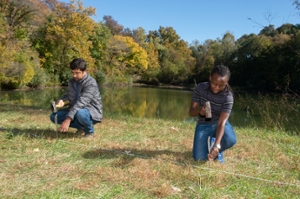 Southern Illinois University Edwardsville School of Engineering hosted a three-day training seminar and workshop Oct. 23-25 focusing on Electrical Resistivity Imaging with the SuperSting Electrical Resistivity Imaging system. After SIUE students participated in the first two days, more than 15 attendees from various companies, the Missouri Departments of Transportation and Natural Resources, and Missouri University of Science and Technology joined for the third day.
Southern Illinois University Edwardsville School of Engineering hosted a three-day training seminar and workshop Oct. 23-25 focusing on Electrical Resistivity Imaging with the SuperSting Electrical Resistivity Imaging system. After SIUE students participated in the first two days, more than 15 attendees from various companies, the Missouri Departments of Transportation and Natural Resources, and Missouri University of Science and Technology joined for the third day.
The American Geosciences Institute (AGI) Resistivity Imaging Seminar was designed for professionals who are involved in, beginning to consider, or have management responsibilities of others currently conducting DC Resistivity or Induced Polarization (IP) imaging surveys.
DC Resistivity and IP imaging is a non-intrusive electrical imaging technique, similar to an MRI or x-ray to diagnose problems in the human body. “It is an emerging technology that leads to significant cost savings for subsurface investigations and constructions,” said Reza Osouli, PhD, associate professor in the SIUE Department of Civil Engineering. “It allows for detection of subsurface geotechnical/logical layers, sinkholes, changes in moisture content, seepage or leakage in dams or levees, depth to bedrock, karst, anomalies or cavities, the boundary of landfills, and heavy metals in waste disposal facilities.”
The hands-on seminar covered DC Resistivity and IP imaging topics such as theory, data acquisition, field procedures, data processing, data presentation, and interpretation using the AGI SuperSting Earth Resistivity/IP/SP System and AGI EarthImager software.
“By hosting this event, the SIUE geotechnical program within civil engineering is further recognized among practitioners, state agencies and academics as a leader in use of innovative methods such as geophysical methods for geotechnical applications within our region,” said Osouli. “Many state and federal agencies, as well as industries, are behind in regard to using such cost-saving techniques. This experience is extremely valuable as it helps establish SIUE as an institution that can expand and develop further applications of this technique for our region.”